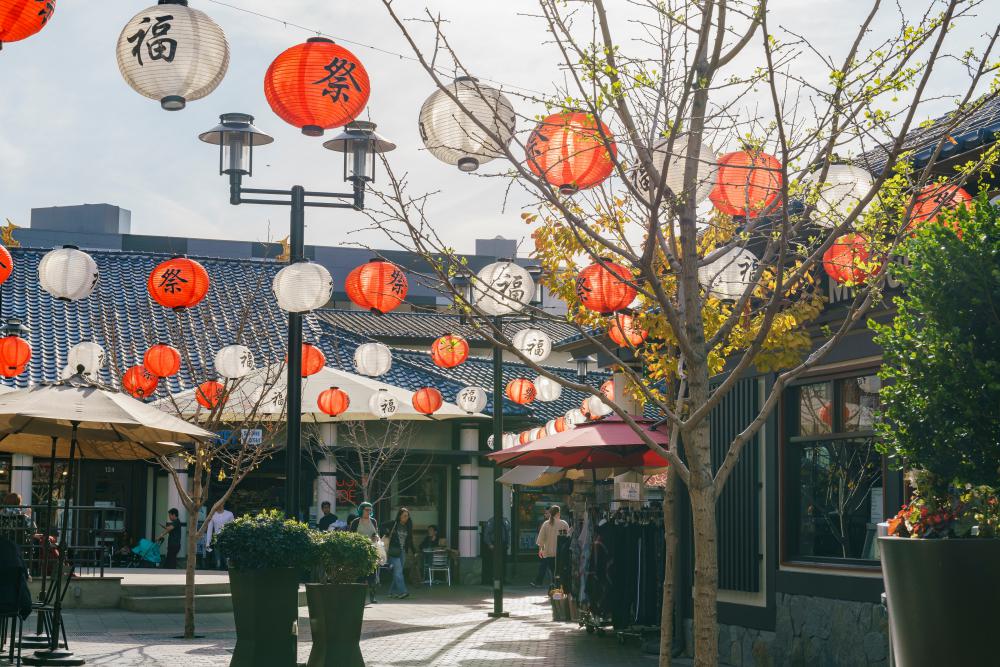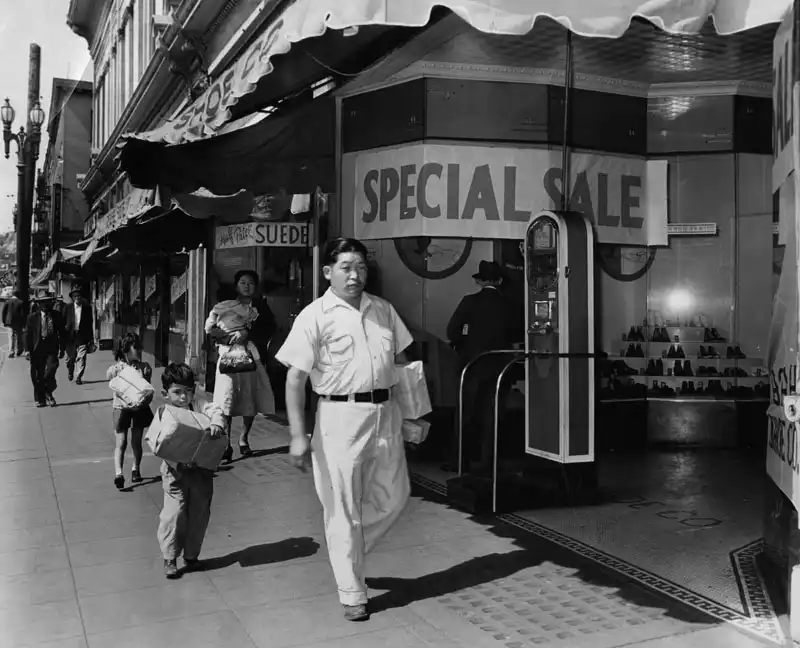By Arielle Schultz
Among the standard Los Angeles streets saturated with mid-century modern, mission revival, and international style structures, a small district of just five city blocks stands out, characterized by a unique Japanese influence, setting it apart from the rest of the city. Little Tokyo is a historic Japanese commercial district nestled in the heart of Los Angeles: Downtown LA (“Little Tokyo Historic District” ). Little Tokyo, one of the three ‘Japantowns’ in the United States, offers a variety of restaurants and cafes specializing in Japanese cuisine, as well as stores offering Japanese goods. The buildings are adorned with distinctive Japanese roofing, and red and white circular lanterns are strung from one establishment to another. Despite Los Angeles being a multicultural and diverse city, Little Tokyo stands out as an anachronistic enclave with a culture and aesthetic that diverges from both Los Angeles and its namesake, Tokyo.

While hordes of tourists and locals may flock to the bustling streets of Little Tokyo for a chance to capture a quick photo or snag a souvenir that provides a taste of Asia without the long flight or the expensive ticket, many remain unaware of the intriguing history behind Little Tokyo’s distinctive blend of American and Japanese influences. The origins of Little Tokyo can be traced back, in part, to the aftermath of the Chinese Exclusion Act of 1882 (“Little Tokyo Historic District”). Following the decline of Chinese laborers, Japanese workers gained increased importance to American businesses, resulting in a rapid influx of Japanese immigrants in cities along the West Coast. Los Angeles, in particular, became a focal point in 1884 when Hamanosuke Shigeta, a retired sailor and one of about 70 Japanese residents, opened the doors to his restaurant. This marked a milestone as the first Japanese-owned business in the city and is considered the pivotal moment known as the “Birth of Little Tokyo” (“LA Honors”). After decades of growth, by 1942, Little Tokyo cemented itself as a vibrant community with more than 35,000 members working and living there.
While Little Tokyo sought to emulate the cultural and architectural aspects of their home place, it was impossible to prevent elements of standard American life from seeping into their enclave. The prosperity of Little Tokyo faced severe setbacks following the bombing of Pearl Harbor, as the United States retaliated with Executive Order 9066, fueled by hysteria and distrust toward Japanese-Americans. This executive order compelled 120,000 people of Japanese descent to relocate away from the West Coast (“Little Tokyo Historic District”). Consequently, this act of tyranny turned Little Tokyo into a virtual ghost town. Because of these newfound vacancies and the racial segregation that ostracized Black residents from many other neighborhoods, African-American families started to inhabit what used to be Little Tokyo, briefly converting the district into a Black enclave penned Bronzeville until the end of World War II (Florido 2017).
Even as Japanese Americans returned to Little Tokyo, rekindling its Japanese influence, many Black Americans continued to reside in the district and coexist with the Japanese residents. The establishment of the Common Ground Committee aimed to cultivate positive interracial relations, and Japanese businesses that successfully renewed their leases actively employed the new Black residents, and reciprocally, Black-owned businesses hired Japanese residents (“Little Tokyo Historic District”). Even though Bronzeville no longer exists, according to the 2010 Census, Little Tokyo is still 25.9 percent Black American, highlighting how this ethnic enclave has adapted to its surrounding demographics (Painter 2015, 1).

If one strolls through the blocks of Little Tokyo today, the distinct fusion of Japanese and mainstream American culture remains the defining characteristic of the place. A business that perfectly captures this multicultural identity is Japangeles. Not only does its name serve as a symbolic representation of Little Tokyo’s American influence, but numerous clothing products on display feature traditional Japanese aesthetics but are presented in English lettering, showcasing the process of Americanization within Japanese culture.
However, Little Tokyo is not the sole example of this distinctive cultural amalgamation. Countless cities across the United States and worldwide have areas designed to replicate the ancestral home place of a specific minority group. For example, São Paulo, Brazil, is home to their own Japantown, known as Liberdade, and there is also Little Havana, a neighborhood inside Miami. As time passes, these spaces have all evolved into entirely new places that blend elements of the surrounding mainstream culture with the heritage of the given immigrant group. These places of cultural fusion can provide a safe haven for immigrants struggling with homesickness, nostalgia, and root shock and offer a less jarring path to acclimatization in an unfamiliar land.

That being said, the authenticity of these ethnic enclaves’ culture can be threatened through the process of gentrification. This transformation often occurs when the place in question flourishes and becomes sought out by people who earn a higher income with a “desire for an authentic urban experience” (Zukin 2010, 4). Sharon Zukin defines authenticity as the “expectation that neighbors and buildings that are here today will be here tomorrow” (Zukin 2010, 6). The gentrifiers who search for authenticity are ironically compromising the place’s continuity, and therefore authenticity, by pushing out long-term residents due to the rising cost of living and property values.
Circling back to Little Tokyo, its residents are confronting the concrete consequences of gentrification due to a surge in interest in Japanese culture and the subsequent commodification of Little Tokyo’s authenticity (Anabel 2022). As demonstrated by the earlier example of Japangeles, there are already businesses capitalizing on Little Tokyo’s distinctive and multicultural identity. Locals express their worry that this new business environment and the rising rents are starting to erase the established culture cultivated by the original shop owners of Little Tokyo, who had settled in the town 135 years ago.
As we reflect on the story of Little Tokyo and ethnic enclaves similar to it, it is essential to remember to safeguard the authenticity and heritage of these communities while simultaneously appreciating their unique cultural offerings. We must support policies that preserve the unique character of these neighborhoods, ensuring that they remain culturally rich while also avoiding the disastrous effects of gentrification. Our actions can help protect the very essence that makes these places so unique as well as preserve their legacy for future generations to serve as a reminder of the beauty that multiculturalism produces.
Works Cited:
Anabel. “Little Tokyo: A Community of Fading Tradition.” High School Insider, August 5, 2022. https://highschool.latimes.com/university-high-school-2/little-tokyo-a-community-of-fading-tradition/.
Florido, Adrian. “How ‘little Tokyo’ of Los Angeles Changed into ‘Bronzeville’ and Back Again.” NPR, February 19, 2017. https://www.npr.org/2017/02/19/516064700/how-little-tokyo-of-los-angeles-changed-into-bronzeville-and-back-again.
“LA Honors Former Restaurant as First Japanese-Owned Business in Little Tokyo.” MyNewsLA.com, January 12, 2022. https://mynewsla.com/business/2022/01/12/la-honors-former-restaurant-as-first-japanese-owned-business-in-little-tokyo/.
“Little Tokyo Historic District.” National Parks Service, October 12, 2023. https://www.nps.gov/places/little-tokyo-historic-district.htm#:~:text=Little%20Tokyo%20Historic%20District%20is,community%20in%20the%20United%20States.
Painter, Gary, Jung Hyon Choi, and Vincent Reina. “Little Tokyo Community Assessment.” Sol Price Center for Social Innovation, 2015. https://socialinnovation.usc.edu/files/2013/01/Little-Tokyo-Community-Assessment-093016-Final_with-description.pdf.
